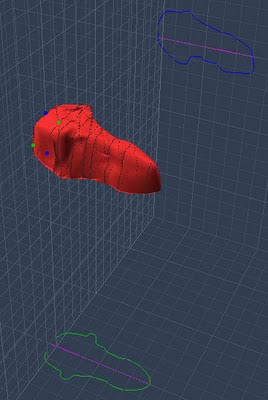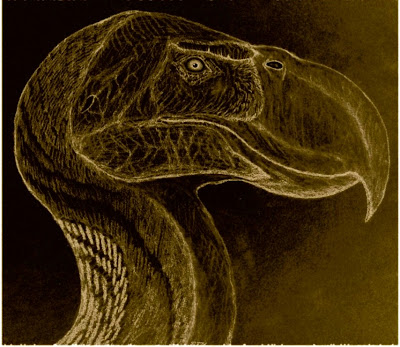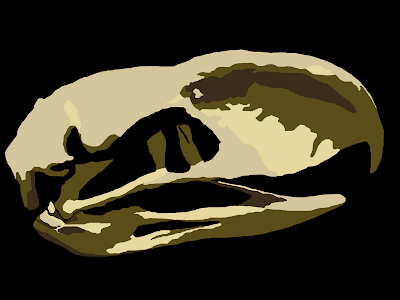At Craig's request I am cross-posting this subject here, as it's a very urgent and important issue that's come up. If you want to look at the comments it's already generated on my blog, click on the link to The Paleo King on the left of the screen.
Ok for those of you dino fans who haven't been keeping track of the Dinosaur Mailing List (and I don't blame you, because it's a pretty bland and downright primitive operation by modern internet standards) there has been some major chatter regarding the use of world-renowned paleoartist Greg Paul's work.
Some people have been stealing his work. And making money off of their plagiarism - not just that, they are undercutting Greg by willing to charge far less to museum curators, exhibit planners, publishing companies, etc. I'm not talking about simply making art that looks like his style or level of detail - I mean they're literally tracing, copying, and simply recoloring EXACT IDENTICAL replicas of his work. And he's suing.
Now ordinarily you might say "big deal. He should go ahead and sue their pants off". And rightfully so - stealing and devaluing work like that is one of the biggest problems in any commercial art industry and it needs to be dealt with. But it's not quite as simple as all that. He's gone far further - now he's basically threatening to sue artists for a far more draconian range of "offenses", even things as minor as how the legs and feet are posed. This goes beyond defense of intellectual property - I think this approach is vigilante and excessive.
Now I don't want to misrepresent what he's saying, so here are his actual statements on different areas of the problem, with context:
SKELETALS:
"The basic rule needs to be that that an artist produce their own
skeletal restoration based on original research. This would include
using photos of the skeleton, or an illustrated technical paper on the
particular taxon. This then goes into your files as documentation of
originality, and you can publish it.
Do not pose it in my classic left foot pushing off in a high velocity
posture. Not because I am inherently outraged -- it would be rather
nice if not for some practical issues. For one thing I have succeeded
in getting some big payments for unauthorized use of this pose by major
projects that should have known better. Aside from the financial issue,
there are other concerns if you think about it. It is widely assumed that
any skeleton in this pose is mine, but what if it does not meet my level
of accuracy? The trust in and value of my work is degraded. There are
gigillions of poses a skeleton can be placed in. Be original.
Lots of original skeletal restorations do not look much like mine -- I
suspect because they are not necessarily as accurate. If someone's
original skeletal restoration is close to mine that is OK as long as
they have the documentation of originality....
You apparently either have to have extensive documentation for each image (try proving what your sources were in a court of law, where attorneys have to go by their eyes and know nothing of the positions of zygapophyses on a skeletal), or make inaccurate skeletals or run the risk of being branded a "Greg Paul clone" and getting sued. Which is truly a sad proposition because it means that by going after merely similar poses rather than blatant intellectual property fraud, more and more legitimate paleo-artists will feel uneasy about staying in the profession. If nobody but Greg Paul is making accurate skeletals, there's nobody else to use as a technical reference for complex paintings. And then you either have to pay up for the privilege or just get out of the profession altogether. This isn't going to stop those who intentionally copy and underbid Greg Paul from continuing to do so. Thieves who copy Greg wholesale aren't going to be deterred by a draconian blanket risk of a fine for any slight semblance to his work if they think they can get away with far worse (and have already done so). Law-abiding artists however will be intimidated and discouraged by such blunt and imprecise punishment tactics because they don't want their finances and reputation ruined. They actually
do care.
"...Perhaps you are thinking that it sounds like a whole lot of work to have to
go to the trouble to do original skeletal restorations for all these
dinosaurs, all the more so when a set of excellent skeletal restorations is
already available.
Exactly. That is the whole point."
We now need files to make sure we can defend our work in case we get sued? Isn't that a bit far to go? I personally have lots of papers on file and photographs too, so when I draw bones for a restoration it's from the original research and actual photographs, not Greg Paul's products. But not everyone has access to these - and not everyone can tell the difference at a glance between well-researched skeletals by two different artists. Of course I try to document my own research on this blog; I've always tried to avoid relying on anyone's previous skeletals as references (including Greg Paul's) and I was fortunate enough to have friends who hooked me up with huge numbers of rare source papers on dinosaurs that have been enormously helpful in my research, but the potential that anyone can get sued if their work merely looks like something Greg Paul could have done is frightening. In other words, give up, NOW.
Furthermore, his warning not to do a skeletal in the pose he uses (left foot pushing off) comes across as nothing short of megalomania. The precedent of his having sued the people behind "major projects that should have known better" is hardly a "practical issue". It's putting the cart before the horse. So now because he sued one person who used a similar pose (but possibly for a totally original skeletal OR a plagiarism - Greg's a bit vague on that point) then nobody can pose their original skeletals that way? The details of that case are not even known to us!
You can copyright an image, but you can't copyright a pose. Who knows, just as with the whole idea of black and white skeletal drawings, Greg Paul may not even be the first person to use such a pose. It makes no sense to copyright a pose for a skeletal of all things, since they are all in profile and most are not necessarily unique "life" poses. On the other hand, if we're talking about a drawing or painting of a live scene in action (i.e. perspective poses, not bland profiles) then if your poses look like those of a specific Greg Paul painting you are in the wrong and can be sued since for a live scene you have to replicate both the pose and the angle to make it have the same "pose" as a Greg Paul work.
For example you could draw a T. rex in the same pose as the his famous T. rex pair painting (running, with head turned right), but draw it from a completely different angle, and with different patterns, color, texture, etc. There is no grounds to sue for this, because from a different angle there is no spatial resemblance to the Greg Paul painting. There are only so many anatomically accurate poses a T. rex could be in. There aren't "gigillions" of poses for a skeletal either, and the fact that a skeletal is usually in profile limits the number of angles to just one for primary profile skeletals. There are only so many ways you can pose a profile skeletal and still have it be accurate. Theropods need that s-curve in their necks, brachiosaurs need vertical necks, diplodocids roughly horizontal, tyrannosaur arms have to be supinated (facing inwards), and walking/running poses (and even tail poses) are limited by the biomechanics of the animal. Even if you try to make the pose different from a Greg Paul pose, it will probably still bear some similarity if you want the thing to be accurate! Unless you make it a snapshot "action" pose like Jaime Headden and some other artists are known to do, but that just makes it more tedious to illustrate. There aren't gazillions of ways to restore a dinosaur, especially not in terms of posing a skeletal profile. Indeed Greg Paul himself said something remarkably similar in his 1991 paper on dinosaur myths:
Myth: At the end of a heated discussion, often I have heard the retort, "well, there is
more than one way to restore a dinosaur!"
Reality: A dubious statement at best, it is becoming less and less true as we learn more and more about the actual appearance of dinosaurs. After all, each taxa had a particular form and appearance in life, and in many cases we know what this form was (Paul, 1987a). Hadrosaurs have down curved rather than straight anterior dorsal columns, soft dorsal frills are often preserved, and their skin is well documented. The knees of giant theropods, ornithopods, and ceratopsids articulated correctly only when they were flexed like those of birds, they did not have the straight knees of elephants (Paul, 1987a). Of course, there are many other things we do not know, and many areas remain open to dispute. Even so, I have noticed that the above statement is usually voiced when the speaker has run out of specific arguments for their case. So it contains little useful information, and it encourages the anything goes attitude that long plagued the field of paleorestoration.
Either you're an anything goes proponent of dubious ways of looking at dinosaur anatomy, or you're potentially an intellectual property thief.... seems to be what his statements add up to. Which smells like total hypocrisy in my book. The fact is, as long as you do your own research, it shouldn't matter what pose you use, there are only so many accurate or plausible ones. And there is no single Greg Paul pose for any one dinosaur. He's revised all of his skeletals, changed things like arm poses, neck poses, etc. So now are all his current and former neck and arm poses off limits for illustrators? Even if every bone in another artist's skeletal skeletal is the original illustration of that artist? Should every artist then come up with a trademark pose, that no other artist in the future can ever use? There would quickly be no realistic poses left!
HOW SHOULD YOU DO THEM?
"So the choices are these --
Do your own researched and produced skeletal restorations in an original
pose. If some of these turn out it is very similar to mine that's OK as long
as the documentation exists.
Do not do your own skeletal restorations, but do not copy my art either
(i.e. stay away from the Greg Paul look). There are some current artists who
do this and they are not violating my copyrights. I of course prefer to think
such work is not as accurate as mine but what do I know."
That better be a typo. Do do your own skeletals but don't do them, and don't copy mine either? That's a catch-22 if I ever heard one. Greg Paul's not the only person who can do skeletals. But of course if you're not Greg Paul, don't even try to do your own skeletals, because even if you're being original and not cheating, you're still never going to be as accurate so might as well give up now!
Don't get me wrong, I'm actually in Greg's corner for most of this issue, but even though he's probably done more skeletals than anyone, claiming a monopoly over the right to produce skeletals for commercial work is no more ethical than stealing someone else's skeletals and passing them off as your own. So I hope that really is a typo.
However this does not mean that skeletals should all be open-source. Some artists do make them open-source, while others simply cannot afford to. Greg Paul makes a living off of art, so for him this is not a viable option. I'm all for seeing less experienced artists who do not have a good working knowledge of dinosaur anatomy (and hence can't make their own skeletals) paying for the right to use Greg Paul's skeletals as resources for their commercial work. He deserves the money. However, to make something as unavoidably ubiquitous as certain skeletal poses "closed-source" runs the risk of successively making it impossible for any artist to avoid getting sued because there is a limit to how many ways you can accurately pose any one dinosaur in a profile skeletal. As years and decades pass, and more unique poses get "claimed" as trademarks by various new artists, it will become exponentially harder to find your own and still remain accurate. If you make a simple pose a copyright violation, then everyone will be a criminal at some point - perhaps in less than a hundred or even fifty years - unless you want to get really crazy and put your skeletals in all sorts of crazy barely believable dislocated poses. And even after a while of new artists doing that, it would get even harder to be fully "original" in posing. As they age and die, who will their copyrights pass to? Family or some big corporate trust? When the copyrights expire will it be legal to once again use accurate poses? Or will the profession become so choked by litigation that it will die and publishers in the next century will simply have to continue using old licensed illustrations by long-gone artists? Shouldn't the content matter more than the pose? This brave new world of trademarked poses looks like nothing so much as a key to a Pandora's Box of insanity.
ANOTHER PERSPECTIVE:
Scott Hartman, whose skeletal drawings have a roughly similar pose to Greg Paul's, has offered to change the poses on all of them, though since there are over a hundred, this may take a very long time. He claims that Greg was very gracious and did not threaten any litigation, but that his warnings are more like "best practices". While he's totally right on this, I don't know how reasonable it is to go change everything for reasons that have nothing to do with updated research, especially when this might make the skeletals less accurate.
Here's Scott's response:
Greg Paul's posts have garnered a polarized array of responses. I
don't really want to add to the cacophony of people addressing
specific legal claims, but regarding the issue of skeletal poses I'd
note that Greg did not seem (to me) to be making a copyright/trademark
claim as much as a statement on "best practices" based on his
practical concerns about branding and such. Note that it came in a
section of his post that was aimed at artists who potentially want to
do their own reconstructions.
Allowing Greg to establish a branding around the poses he popularized
is a request I'm inclined to grant; after corresponding briefly with
Greg I've decided to embark on the process of reposing my 100+
skeletal reconstructions.
I want to be clear: Greg did not contact me about changing my
skeletals, nor was he anything but gracious in the discussion. I'm
not doing this out of fear of litigation. I've been asked innumerable
times by others why I haven't adopted my "own" pose so I'm simply
using this as a final impetus to do so.
Like Mike Taylor, I lament that the situation has reached the point
where commercial concerns outweigh the scientific utility of posing
animals consistently. I had earnestly hoped that by adopting the same
pose that I would be helping to "standardize" this aspect of skeletal
reconstructions to better facilitate comparison.
So there you have it. I don't agree on the posing issue; suing for a skeletal pose seems pointless and unfair if the actual bones are drawn differently and the result of original research (like that of Scott Hartman). However changing the poses was Scott's personal choice based on many reasons that mostly had nothing to do with Greg Paul, and I can respect that. The tricky thing about the point Scott brings up is whether artists should even have a "signature pose" or not. Theoretically, not all artists would even want any part of this world of everyone having their own copyrighted pose - this could eventually lead to successive closure or exclusivization of poses through copyright attrition. If we all have to avoid using "popular" or previously used poses like the plague, two problems pop up: 1) it's harder to compare skeletals of the same species by two different artists; 2) everyone's going to be in a heightened state of paranoia about avoiding looking too much like another artist's skeletals while simultaneously trying to remain accurate. There are only so many ways you can interpret accurate poses in profile without inadvertently "imitating" somebody else, and as time goes on the number of options will get exponentially smaller and more miserable. Of course directly copying others' work is flat-out wrong and can also unintentionally lead to replicating their mistakes and causing widespread inaccuracies in the field (something else that Greg touches on in his posts to the DML, and was also sadly common for many years with people ripping off the outdated paintings of Knight and Burian). But a simple profile pose isn't going to lead to those same errors, nor does it in any way imply a wholesale ripoff. The question is where do you draw the line? At what point can a mere pose be considered a "brand" or a trademark? Can it?
What's your perspective on this? Feel free to post comments below.
Here,
here, and
here are Greg Paul's original posts on the DML for reference.
P.S. I plan to cover the problem of paleoart fraud in later posts. So don't forget to remind me :)
P.P.S. I'm considering not even touching taxa for which I believe Greg Paul has done a ridiculously unsurpassable and above all iconic skeletal (such as Giraffatitan). So far I'm only planning skeletals of more obscure species, almost all of them titanosaurs. And I've got plenty of documentation in digital form, which I plan to post on my blog as each skeletal or other restoration gets completed. I understand the concern about inventing your own pose - the problem is that I don't have access to the same layer-manipulating programs as Scott Hartman and others, and also I'm not in favor of trying to find a "signature pose" because with skeletals (quadrupedal one anyway) there are some limits to how much diversity of poses there can be. Some of my poses are the opposite of Greg Paul's (right foot pushing off, not left) and they all face the opposite direction. So far these skeletals are not commercial projects anyway, and commercial projects were GP's main concern. For commercial projects I'm open to doing a different pose, much as I dislike it. But for all intents and purposes copyrighting a pose on its own is not practical and probably not valid in a court of law.
P.P.P.S. even if the style of some of my work does end up looking roughly similar to Greg Paul's "look", (though strange as it may seem, I actually don't use any of his skeletals for direct reference) the thought of underbidding him makes me sick. Having personally met him and seen the state of his lifestyle, I thinks he's actually under-charging for his work, though this may just be a result of the devaluation of paleo-art that he's complaining about. The thing is, I met him in 1999, long before any of these complaints of intellectual property theft were raised. And even then, he wasn't exactly prosperous. I have no problem with charging twice as much for my work, particularly because it IS my work, not a rehash of his work (and frankly, some of it is better...)


















 What we now need are people's thoughts on these emails and the issues Mr. Paul raises! If you have an opinion on any part (or all parts) of Mr. Paul's emails we want to read them!
What we now need are people's thoughts on these emails and the issues Mr. Paul raises! If you have an opinion on any part (or all parts) of Mr. Paul's emails we want to read them! 


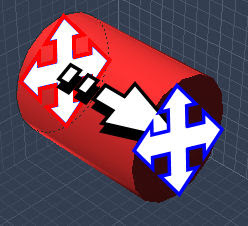
 So
So 

 So let's start with cross section points, as 1. their the most important and 2. you can't start really creating an object without cross sections.
So let's start with cross section points, as 1. their the most important and 2. you can't start really creating an object without cross sections.






 So to easier see how we're changing a cross section we'll want to switch viewpoints. Selecting our view point option pick either Front or Current Selection to get a clear view of a cross section.
So to easier see how we're changing a cross section we'll want to switch viewpoints. Selecting our view point option pick either Front or Current Selection to get a clear view of a cross section. Okay so here is your cross section up close and personal. Again this is the best when to manipulate a cross section. At least at the start of modelling.
Okay so here is your cross section up close and personal. Again this is the best when to manipulate a cross section. At least at the start of modelling. To more easily customize our circle we're going to want to add points. For this select the add point tool again, and add some points to your circle where ever you are going to want to pull, distort, or reshape the cross section's shape.
To more easily customize our circle we're going to want to add points. For this select the add point tool again, and add some points to your circle where ever you are going to want to pull, distort, or reshape the cross section's shape.  Pulling the points around the cross section plane, and modifying the curve with the vector points you can start to make
Pulling the points around the cross section plane, and modifying the curve with the vector points you can start to make 
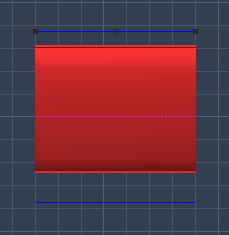 In any
In any  You can grab any of these points and move them along the extrusion plane. Depending on the type of point and the envelope you have selected different things will happen.
You can grab any of these points and move them along the extrusion plane. Depending on the type of point and the envelope you have selected different things will happen. Lastly you can curve and smooth out the connections between points. To do this you'll need to select the vector tool as shown above.
Lastly you can curve and smooth out the connections between points. To do this you'll need to select the vector tool as shown above. With this you can give any point along the extrusion path vector handles that will allow you to curve the connection lines and thus curve your object.
With this you can give any point along the extrusion path vector handles that will allow you to curve the connection lines and thus curve your object.